From Wikipedia, the free encyclopedia
Eirik Håkonsson
 |
Eric's victory in the battle of Svolder was his most celebrated achievement. Painting by Otto Sinding (1842-1909) Eirik Håkonsson or Eric of Norway[1] (960s-1020s) was earl of Lade, ruler of Norway and earl of Northumbria. He was the bastard eldest son of earl Hákon Sigurðarson. He participated in the Battle of Hjörungavágr, the Battle of Svolder and the conquest of England. |
Sources
The most important historical sources on Eirik are the 12th and 13th century kings' sagas, including Heimskringla, Fagrskinna, Ágrip, Knýtlinga saga, Historia Norvegiæ, the Legendary Saga of St. Olaf and the works of Oddr Snorrason and Theodoricus monachus. The Anglo-Saxon sources are scant but valuable as they represent contemporary evidence. The most important are the 11th century Anglo-Saxon Chronicle and the Encomium Emmae but Eirik is also mentioned by the 12th century historians Florence of Worcester, William of Malmesbury and Henry of Huntingdon.
A significant amount of poetry by Eric's skalds is preserved in the kings' sagas and represents contemporary evidence. The most important are the Bandadrápa of Eyjólfr dáðaskáld and the works of Halldórr ókristni and Þórðr Kolbeinsson. Eirik also had Hallfreðr vandræðaskáld, Gunnlaugr ormstunga, Hrafn Önundarson, Skúli Þorsteinsson and Þórðr Sjáreksson as court poets.
Youth
The principal sources on Eric's youth are Fagrskinna and Heimskringla. They relate that Eirik was the son of Hákon Sigurðarson and a woman of low birth whom Hákon bedded during a sojourn in Uppland.[2] Hákon cared little for the boy and gave him to a friend of his to raise.[3] On one occasion when Eirik was 11 or 12 years old he and his foster father had harboured their ship right next to earl Hákon. Then Hákon's closest friend, Skopti, arrived and asked Eirik to move away so that he could harbour next to Hákon as he was used to. When Eirik refused, Hákon was infuriated by the boy's pride and sternly ordered him away. Humiliated, Eirik had no choice but to obey. In the following winter he avenged the humiliation by chasing down Skopti's ship and killing him. This was Eric's first exploit, as commemorated by his skald Eyjólfr dáðaskáld who mentions the incident in his Bandadrápa.[4]
|
|
The above verse gives some idea of the difficulty faced by historians in using skaldic poetry as a source. The verse, assuming it is correctly attributed, informs us that Eirik killed a man named Skopti in a sea battle in his youth. But we are entirely dependent on the kings' sagas to tell us who this Skopti was and what reasons Eirik had to fight him. Many skaldic verses give even less specific information in even more ornate language.
The sagas say that after killing Skopti, Eirik sailed south to Denmark where he was received by king Harald Bluetooth. After a winter's stay in Denmark, Harald granted Eirik earldom over Romerike and Vingulmark - areas in the south of Norway long under Danish influence. In Heimskringla this information is supported with a somewhat vague verse from Bandadrápa.
Battle of Hjörungavágr
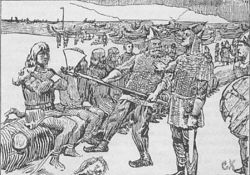 |
Eirik gives quarter to a handsome Jomsviking after the battle of Hjörungavágr. Illustration by Christian Krohg. The Battle of Hjörungavágr was Eric's first major confrontation. The battle was a semi-legendary naval battle that took place in the late 10th century between the earls of Lade and a Danish invasion fleet. The battle is described in the Norse kings' sagas—such as Heimskringla—as well as in Jómsvíkinga saga and Saxo Grammaticus' Gesta Danorum. Those late literary accounts are fanciful but historians believe that they contain a kernel of truth. Some contemporary skaldic poetry alludes to the battle, including verses by Þórðr Kolbeinsson and Tindr Hallkelsson. According to Heimskringla, Eirik, apparently reconciled with his father, commanded 60 ships in the battle and emerged victorious. After the battle he gave quarter to many of the Jomsvikings, including Vagn Ákason. |
Raids in the Baltic
 |
The fortress of Ladoga was originally built in medieval times. In 995, as Óláfr Tryggvason seized power in Norway, Eirik was forced into exile in Sweden.[12] He allied himself with Olof of Sweden and Sweyn Forkbeard whose daughter, Gyða, he married. Using Sweden as his base he launched a series of raiding expeditions into the east. Harrying the lands of king Vladimir I of Kiev, Eirik looted and burned down the town of Ladoga (Old Norse Aldeigja). There are no written continental sources to confirm or refute this but archaeological evidence showing a burning of Ladoga in the late 10th century was unearthed by Soviet archaeologists in the 1980s.[13] Eirik also plundered in western Estonia (ON Aðalsýsla) and the island of Saaremaa (ON Eysýsla). According to the Fagrskinna summary of Bandadrápa he fought vikings in the Baltic and raided Östergötland during the same time.[14] |
Battle of Svolder
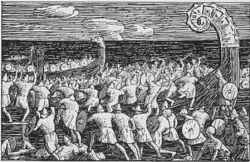
Eric's men board the Long Serpent.
In the Battle of Svolder in 1000, Eirik, Sweyn and Olof, ambushed king Óláfr Tryggvason by the island of Svolder. The place cannot now be identified, as the formation of the Baltic coast has been much modified in the course of subsequent centuries. Svolder was an island probably on the North German coast, near Rügen.
During the summer, Olaf had been in the eastern Baltic. The allies lay in wait for him at the island of Svolder on his way home. The Norwegian king had with him seventy-one vessels, but part of them belonged to an associate, Jarl Sigvaldi, a chief of the Jomsvikings, who was an agent of his enemies, and who deserted him. Olaf's own ships went past the anchorage of Eirik and his allies in a long column without order, as no attack was expected. The king was in the rear of the whole of his best vessels. The allies allowed the bulk of the Norwegian ships to pass, and then stood out to attack Olaf.
Olaf refused to flee, and turned to give battle with the eleven ships immediately about him. The disposition adopted was one which is found recurring in many sea-fights of the middle ages where a fleet had to fight on the defensive. Olaf lashed his ships side to side, his own, the Long Serpent, the finest war-vessel as yet built in the north, being in the middle of the line, where her bows projected beyond the others. The advantage of this arrangement was that it left all hands free to fight, a barrier could be formed with the oars and yards, and the enemy's chance of making use of his superior numbers to attack on both sides would be, as far as possible, limited — a great point when all fighting was with the sword, or with such feeble missile weapons as bows and javelins. Olaf, in fact, turned his eleven ships into a floating fort.
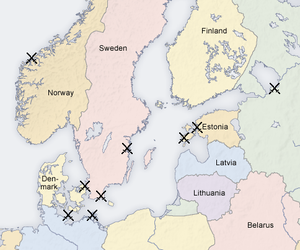
Locations of Eric's battles and raids in Scandinavia and the Baltic.
Modern borders shown for reference.
The Norse writers, who are the main authorities, gave all the credit to the Norwegians, and according to them all the intelligence of Olaf's enemies, and most of their valour, were to be found in Eirik. They say that the Danes and Swedes rushed at the front of Olaf's line without success. Eirik attacked the flank. His vessel, the Iron Ram (ON Járnbarðinn), was "bearded", that is to say, strengthened across the bows by bands of iron, and he forced her between the last and last but one of Olaf's line. In this way the Norwegian ships were carried one by one, till the Long Serpent alone was left. At last she too was overpowered. Olaf leapt into the sea holding his shield edgeways, so that he sank at once and the weight of his hauberk dragged him down.
Eirik captured Olaf's ship, the Long Serpent, and steered it from the battle, an event dwelled upon by his court poet Halldórr ókristni.
Rule of Norway
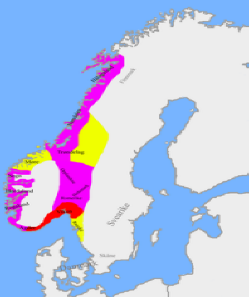
|
After the battle of Svolder, Eirik became, together with his brother Sveinn Håkonsson, governor of Norway under Sweyn Forkbeard from 1000 to 1012. Eric's son, Hákon Eiríksson, continued in this position to 1015. Eirik and Sveinn consolidated their rule by marrying their sister Bergljót to Einarr Þambarskelfir, gaining a valuable advisor and ally. Fagrskinna relates that "there was good peace at this time and very prosperous seasons. The jarls maintained the laws well and were stern in punishing offences."[15] During his rule of Norway, Eric's only serious rival was Erlingr Skjálgsson. Too powerful and cautious to touch but not powerful enough to seek open confrontation he maintained an uneasy peace and alliance with the earls throughout their rule. According to Grettis saga, Eirik forbade duelling by law and exiled berserks shortly before his expedition to England.[16] |
| After the Battle of Svolder, Eirik ruled the area marked purple on the map. The yellow area was held by his half-brother, Sveinn, in trust for the Swedish king while the red area was under direct control of the king of Denmark. |
Religion
According to Theodoricus Monachus, Eirik pledged to adopt Christianity if he emerged victorious from the battle of Svolder.[17] Oddr Snorrason's Óláfs saga Tryggvasonar has a more elaborate version of the story[18] where Eirik replaces an image of Thor on the prow of his ship with a Christian cross. There is no skaldic poetry to substantiate this but most of the sagas agree that Eirik and Sveinn adopted Christianity, at least formally.
Fagrskinna says: "These jarls had had themselves baptised, and remained Christian, but they forced no man to Christianity, but allowed each to do as he wished, and in their day Christianity was greatly harmed, so that throughout Upplönd and in over Þrándheimr almost everything was heathen, though Christianity was maintained along the coast."[19]
Adopting Christianity was no doubt a politically advantageous move for the earls since they were allied with the Christian rulers of Sweden and Denmark. Instituting freedom of religion was also a shrewd political move after Óláfr Tryggvason's violent missionary activity. Eric's religious conviction as a Christian was probably not strong.[20] While the court poets of Eric's rivals, Óláfr Tryggvason and Óláfr Haraldsson, censored heathen kennings from their poetry and praised their lord as a Christian ruler, all surviving court poetry devoted to Eirik is entirely traditional.[21] The Bandadrápa, composed sometime after 1000, is explicitly pagan - its refrain says that Eirik conquers lands according to the will of the heathen gods. Even the poetry of Þórðr Kolbeinsson, composed no earlier than 1016, has no indication of Christian influence. According to Historia Norwegie and Ágrip, Eirik actively worked to uproot Christianity in Norway[22] but this is not corraborated by other sources.
Conquest of England
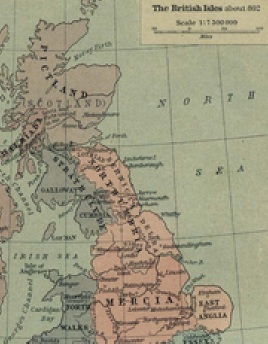 Section from Shepherd's map of the British Isles about 802 AD
Section from Shepherd's map of the British Isles about 802 AD
showing the kingdom of Northumbria
In 1014 or 1015 Eirik left Norway and joined Canute the Great for his campaign in England. Judging from Þórðr Kolbeinsson's Eiríksdrápa their fleets met off the English coast (in 1015) but the chronology of the various sources is difficult to reconcile and some scholars prefer placing their meeting in 1014 in Denmark.[23] At that time Canute was young and inexperienced but Eirik was "an experienced warrior of tested intelligence and fortune" (Fagrskinna)[24] and, in the opinion of Frank Stenton, "the best adviser that could have been found for a young prince setting out on a career of conquest".[25]
The Scandinavian invasion fleet landed at Sandwich in midsummer 1015 where it met little resistance. Canute's forces moved into Wessex and plundered in Dorset, Wiltshire and Somerset. Alderman Eadric Streona assembled an English force of 40 ships and submitted to Canute.[26] The Encomium Emmae is the only English source which gives any information on Eric's actions at this time but its account of his supposed independent raids is vague and does not fit well with other sources.[27]
In early 1016 the Scandinavian army moved over the Thames into Mercia, plundering as it went. Prince Edmund attempted to muster an army to resist the invasion but his efforts were not successful and Canute's forces continued unhindered into Northumbria where Uhtred the Bold, earl of Northumbria, was murdered.[28] The great north English earldom was given by Canute to Eirik after he had won control of the north. After conquering Northumbria the invading army turned south again towards London. Before they arrived King Ethelred the Unready died (on April 23) and Prince Edmund was chosen king.[29]
Following Ethelred's death the Scandinavian forces besieged London. According to the Encomium Emmae the siege was overseen by Eirik and this may well be accurate.[30] The Legendary Saga of St. Olaf indicates that Eirik was present at the siege of London[31] and a verse by Þórðr Kolbeinsson says that Eirik fought a battle with Ulfkytel "west of London".
After several battles, Canute and Edmund reached an agreement to divide the kingdom but Edmund died a few months later. And in 1017 Canute was undisputed king of all England. He divided the kingdom into four parts; Wessex he kept for himself, East-Anglia he gave to Thorkell, Northumbria to Eirik and Mercia to Eadric. Later the same year Canute had Eadric executed as a traitor. According to the Encomium Emmae he ordered Eirik to "pay this man what we owe him" and he chopped off his head with his axe.[32]
Eirik remained as earl of Northumbria until his death. His earlship is primarily notable in that it is never recorded that he ever fought with the Scots or the Britons of Strathclyde, who were usually constantly threatening Northumbria. Eirik is not mentioned in English documents after 1023. According to English sources[33] he was exiled by Canute and returned to Norway. This is very unlikely as there are no Norse records of his supposed return. Eric's successor as earl, Siward, can not be confirmed as being earl of Northumbria until 1033 so Eric's death can not strictly be placed more precisely than between 1023 and 1033. According to the Norse sources he died of a hemorrhage after having his uvula cut (a procedure in medieval medicine) either just before or just after a pilgrimage to Rome.
Notes
- ^ Eirik is referred to in various ways in the mediaeval sources and by modern scholars. He most commonly witnessed charters as Yric dux but he is referred to variously as Yric, Yrric, Iric, Eiric or Eirik by 11th century Latin and Old English sources. In Old Norse sources he is most commonly (with normalized orthography) Eirik jarl or Eirik jarl Håkonsson but sometimes as Eirekr. Modern historians usually use his patronym and refer to him as Eirik Håkonsson or some variant of that (e.g. Eirik/Erik/Eric Hakonarson/Håkonsson/Hakonson) while some prefer Eric of Hlathir or Eric of Norway.
- ^ According to Fagrskinna, Hákon was 15 years old at the time. See Finley, 2004, p. 109.
- ^ Heimskringla, Haralds saga gráfeldar, chapter 8.
- ^ The incident is related both in Fagrskinna and Heimskringla and both cite Bandadrápa as confirmation.
- ^ Here taken from Eysteinn Björnsson's online edition of the skaldic corpus.
- ^ Meiti is one of the sea kings. Meiti's meeting is a kenning for "(sea) battle".
- ^ Fishing-ground's ski is a kenning for "ship".
- ^ Shield-rim's meadow is a kenning for "shield". Red fire of the shield is a kenning for "sword". Raiser of the sword is a kenning for "warrior".
- ^ Blood-falcon is a kenning for "raven".
- ^ Finlay 2004, p. 110.
- ^ Hollander 1991, p. 160.
- ^ Historia Norvegiae (Ekrem 2003, p. 95) says that Eric went to king Sveinn in Denmark but Ágrip (Driscoll 1995, p. 24), Fagrskinna (Finlay 2004, p. 111) and Heimskringla (Snorri Sturluson 1991, p. 193-194) agree that he went to Sweden and Heimskringla cites verses by Þórðr Kolbeinsson to confirm this.
- ^ See Jackson 2001, p. 108 or the online edition at [1].
- ^ Finlay 2004, p. 131.
- ^ Finlay 2004, p. 132.
- ^ Fox 2001, page 39. See [2] for an alternative translation (by William Morris and Eiríkr Magnússon) of the relevant chapter or [3] for an edition of the Old Norse text.
- ^ Theodoricus monachus 1998, p. 18.
- ^ Oddr Snorrason 2003, p. 127.
- ^ Finlay 2004, p. 132.
- ^ Finnur Jónsson 1924, p. 47.
- ^ Christiansen 2002, p. 273.
- ^ Driscoll 1995, p. 35; Ekrem 2003, p. 101.
- ^ Campbell 1998, p. 69.
- ^ Finlay 2004, p. 132.
- ^ Stenton 2001, p. 387.
- ^ The Anglo-Saxon Chronicle. See [4].
- ^ See Campbell 1998, p. 23 and lviii.
- ^ The Anglo-Saxon Chronicle. See [5].
- ^ The Anglo-Saxon Chronicle. See [6].
- ^ See Campbell 1998, p. 23 and lviii.
- ^ Keyser 1849, p. 8.
- ^ Campbell 1998, p. 33.
- ^ William of Malmesbury and Henry of Huntingdon, see Campbell 1998, p. 70 and Greenway 2002, p. 16.
References
- Campbell, Alistar (editor and translator) and Simon Keynes (supplementary introduction) (1998). Encomium Emmae Reginae. Cambridge University Press. ISBN 0521626552
- Christiansen, Eric (2002). The Norsemen in the Viking Age. Blackwell Publishing. ISBN 0631216774
- Driscoll, M. J. (editor) (1995). Ágrip af Nóregskonungasǫgum. Viking Society for Northern Research. ISBN 090352127X
- Ekrem, Inger (editor), Lars Boje Mortensen (editor) and Peter Fisher (translator) (2003). Historia Norwegie. Museum Tusculanum Press. ISBN 8772898135
- Faulkes, Anthony (editor) (1978). Two Icelandic Stories : Hreiðars þáttr : Orms þáttr. Viking Society for Northern Research. ISBN 0903521008
- Finlay, Alison (editor and translator) (2004). Fagrskinna, a Catalogue of the Kings of Norway. Brill Academic Publishers. ISBN 9004131728
- Finnur Jónsson (1924). Den oldnorske og oldislandske litteraturs historie. G. E. C. Gad.
- Fox, Denton and Hermann Pálsson (translators) (2001). Grettir's Saga. University of Toronto Press. ISBN 0802061656
- Henry of Huntingdon (translated by Diana Greenway) (2002). The History of the English People, 1000-1154. ISBN 0192840754
- Jackson, Tatiana (Татьяна Николаевна Джаксон). Austr í Görðum: древнерусские топонимы в древнескандинавских источниках. Moscow, Yazyki Slavyanskoi Kultury, 2001. ISBN 5944570229
- Keyser, Rudolph and Carl Rikard Unger (eds.) (1849). Olafs saga hins helga. Feilberg & Landmark.
- Oddr Snorrason (translated by Theodore M. Andersson) (2003). The Saga of Olaf Tryggvason. Cornell University Press. ISBN 0801441498
- Snorri Sturluson (translated by Lee M. Hollander). (1991). Heimskringla : History of the Kings of Norway. University of Texas Press. ISBN 0292730616
- Stenton, Frank M. (2001). Anglo-Saxon England. Oxford University Press. ISBN 0192801392
- Theodoricus monachus (translated and annotated by David and Ian McDougall with an introduction by Peter Foote) (1998). The Ancient History of the Norwegian Kings. Viking Society for Northern Research. ISBN 0903521407
Retrieved from "https://en.wikipedia.org/wiki/Eirik_H%C3%A5konsson"


